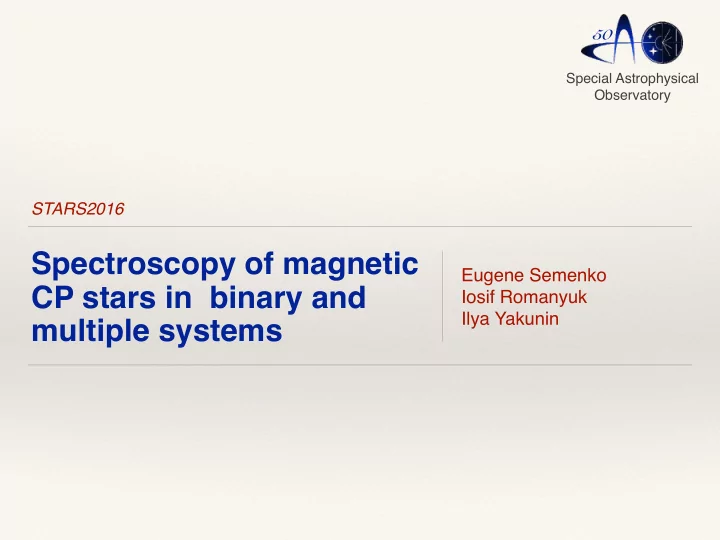

50 Special Astrophysical Observatory STARS2016 Spectroscopy of magnetic Eugene Semenko CP stars in binary and Iosif Romanyuk Ilya Yakunin multiple systems
Role of multiplicity in stellar physics Binary stars are the important method to ‘weight’ the stars ❖ Frequency of multiple systems is closely related to the process of star formation: ❖ mass of a protostellar cloud, - processes of cloud fragmentation. - Magnetic field may affect the formation of close pairs ❖
What is the real number of multiples? Total number of magnetic CP stars is more than 500 at the moment (>150 new ❖ mCP’s from 2006) To detect a binary system different methods are in use (direct imaging, active and ❖ adaptive optics, speckle interferometry, spectroscopy) The frequency of spectroscopic binaries is sensitive to selection effects (radial ❖ velocity varies slowly or non-uniformly) Problem of ‘hidden’ binaries among newly discovered magnetic stars is related to ❖ the insufficient number of observations
Interesting cases of binary and multiple stars
Interesting cases of binary and multiple stars BD +40° 175 is the only visual binary where both components ( m v = 9.5 and 9.9 ❖ mag, ρ = 3.7 ″ ) are magnetic (opposite polarity) Surface field was measured from echelle spectra and exceeds 10 kG ❖ Physical properties are typical to roAp (Teff = 7700 K, log g = 4.0, abundance ❖ anomalies for Pr, Nd, and Tb) Rotational periods are unknown ❖
Interesting cases of binary and multiple stars. BD +40° 175
Interesting cases of binary and multiple stars HD 6757 is a known multiple system ADS 936 AB ( m 1 = 8.05, m 2 = 9.5 mag, ρ = ❖ 0.3 ″ (1876), 0.7 ″ (2015)). Expected orbital period is about 1000 years Ongoing monitoring of the magnetic field at SAO’s 6-m telescope ❖ Rotational period P rot = 2.655 days ❖ Magnetic dipole model: B d ≈ 9800 G, β ≈ 25°, i ≈ 15° if R ≈ 2 R ⦿ . From spectra < B s > ❖ = 10400 ± 400 G
Interesting cases of binary and multiple stars. HD 6757
Interesting cases of binary and multiple stars. HD 6757
Interesting cases of binary and multiple stars HD 6757 shows the signatures of at least one additional component (features in ❖ hydrogen lines and photometric variability with P = 358 days) The radial velocity of brighter component is nearly constant (-5 km/s). The secondary is a ❖ spectroscopic binary star.
Interesting cases of binary and multiple stars. HD 6757
Interesting cases of binary and multiple stars. HD 6757
Interesting cases of binary and multiple stars HD 36313 is a member of Ori OB1 association ( t is about 2 Myr). ❖ Binary system ( ρ = 0.2 ″ , Δ m = 1.5 mag) ❖ Main component is a fast rotating star ( v sin i > 80 km/s, P rot = 1.1786 days) ❖ Composite spectrum contains narrow lines of the secondary star ( v sin i = 25 km/s) ❖ The longitudinal field is measurable only in hydrogen wings (-1.5…+2 kG) ❖ See in details in poster A4
Future prospectives To combine the data of spectroscopy, photometry and speckle-interferometry ❖ To make careful analysis of all available data for the new magnetic stars discovered ❖ at SAO To continue the monitoring of the selected stars with the 6-m telescope ❖
Recommend
More recommend